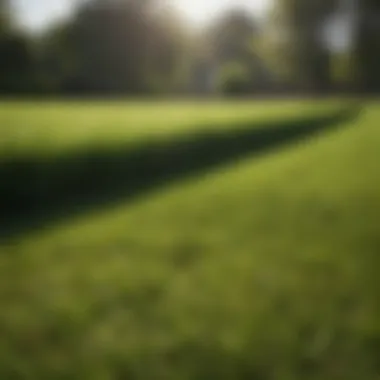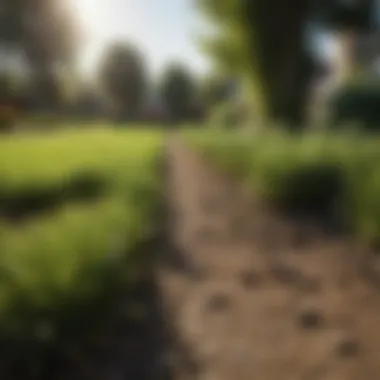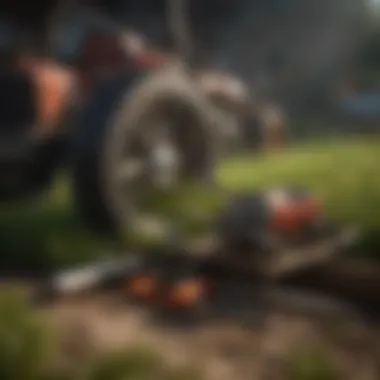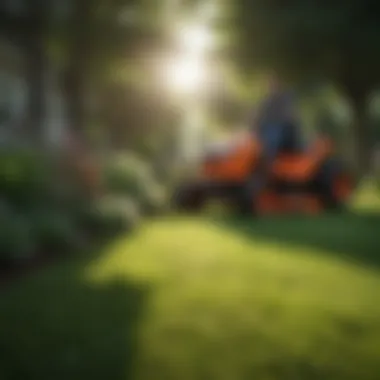Cost Analysis of Resodding Lawns: A Detailed Guide


Intro
Resodding lawns presents a crucial decision for homeowners, farmers, and gardening enthusiasts. The appearance and health of a lawn not only contribute to the aesthetic value of a property but also reflect the owner’s commitment to landscape maintenance. However, the costs associated with resodding can vary immensely based on numerous factors. Understanding these factors equips individuals with the knowledge needed to make informed decisions that align with their lawn care goals.
Overview of the Topic
Definition and Importance
Resodding refers to the process of replacing old or damaged grass with new sod. It is essential for those looking to enhance their lawns’ health, combat invasive species, or restore areas damaged by pests or environmental stressors. A well-maintained lawn can increase property value and provide an inviting outdoor space.
Current Trends
The trend towards sustainable lawn care has gained momentum. Organic resodding methods and drought-resistant sod types are becoming more popular. These practices not only reduce maintenance costs but also promote environmental sustainability. Awareness of soil health and proper drainage systems are also influencing re-sodding decisions in modern landscaping.
Key Techniques and Practices
Step-by-Step Guide
When considering resodding, several steps can maximize success:
- Assess the Lawn: Determine the areas that need sod replacement and check the current soil health.
- Choose the Right Sod Type: Select sod based on the local climate, soil type, and expected foot traffic.
- Prepare the Soil: Clear the area of debris and weeds. Loosen the soil with a tiller to ensure good contact between the sod and soil.
- Lay the Sod: Start laying sod at a corner or edge, ensuring seams are staggered like bricks.
- Watering: Water the sod immediately after installation. Maintain moisture without overwatering.
Tools and Equipment Needed
Essential tools for resodding include:
- Tillers: To prepare the soil.
- Rakes: For leveling the surface.
- Shovels: For edging and clearing.
- Rollers: For ensuring sod contact with the soil.
- Sprinklers or hoses: For proper irrigation.
Challenges and Solutions
Common Obstacles
Many challenges can arise during the resodding process. Some common issues include:
- Soil Compaction: This restricts root growth, making it harder for new sod to establish.
- Inadequate Watering: Over or under-watering can damage new sod.
- Weed Resurgence: Weeds can quickly invade newly laid sod, competing for essential nutrients.
Innovative Solutions
To overcome these challenges, consider the following solutions:
- Aeration: Aerating the soil before laying sod can alleviate compaction and enhance root growth.
- Proper Scheduling: Plan installation during cooler months to reduce stress on new sod.
- Mulching and Fertilization: Using organic mulch can suppress weeds and improve soil health.
"Investing the time and resources into a well-planned resodding project can yield significant long-term benefits in lawn health and aesthetics."
As the complexity and variety associated with resodding lawns grow, being informed is more crucial than ever for effective lawn maintenance. Through careful planning, executed techniques, and understanding potential hurdles, one can ensure a successful lawn restoration process.
Preface to Lawn Resodding
Lawn resodding is a topic that deserves attention for its impact on land aesthetics, health, and functionality. Lawns serve not only as a visual element but also as an essential part of the ecosystem. Resodding rejuvenates tired lawns and provides many benefits. Understanding this process is vital for property owners and enthusiasts alike.
Understanding Resodding
Resodding involves replacing the existing grass with fresh sod. This practice can be necessary for various reasons such as severe pest infestations, illness, or improper watering techniques that destroyed the existing lawn. The method differs from seeding, as it uses pre-grown grass, leading to quicker results. The resodding process includes several key steps: preparing the soil, selecting the right sod, laying it correctly, and ensuring proper care afterward. It is essential to follow these steps to achieve a successful and appealing lawn.
Importance of a Healthy Lawn
A healthy lawn is not only attractive but also beneficial in many ways. Well-maintained grass can improve air quality, reduce noise pollution, and support local wildlife. Moreover, a vibrant lawn increases property value significantly. Health issues can arise from a damaged lawn, including soil erosion and weed proliferation. Therefore, resodding becomes crucial in maintaining not only the visual beauty of land but also its ecological balance. Initiating resodding can prevent more extensive problem later, making it a smart long-term decision for any property owner.
"Investing in a healthy lawn through resodding can significantly enhance property value and curb appeal, while also providing environmental benefits."
Factors Influencing Resodding Costs


Understanding the factors that influence the costs of resodding is crucial for anyone considering this lawn care option. These elements impact not only the immediate expenses but also the long-term sustainability of the lawn. By examining each factor in detail, homeowners and lawn care enthusiasts can make informed decisions that align with their budget and objectives.
Lawn Size
The size of the lawn is a fundamental factor when it comes to estimating the cost of resodding. Larger areas naturally require more sod, which directly increases the material costs. For instance, a 1,000 square foot lawn will need approximately 50 to 60 pieces of sod, whereas a 3,000 square foot area will need significantly more.
Furthermore, the size also impacts the labor costs. Larger lawns can demand more time and effort for installation. Thus, residents should carefully measure their lawns and consider this factor when budgeting.
Type of Grass
The choice of grass type can greatly influence the overall costs. Different grass species come with varying price tags. For example, Kentucky bluegrass is typically more expensive than perennial ryegrass, primarily due to its growing requirements and maintenance. Additionally, local climate conditions play a vital role in selecting the right grass.
Choosing a drought-resistant grass might have a higher upfront cost, but it could save money in the long run by reducing water usage and maintenance. Hence, it is important to assess both initial costs and the long-term implications when selecting the type of grass for resodding.
Soil Condition
Soil condition is often an overlooked aspect that can affect resodding costs. If the existing soil has been neglected or suffers from poor drainage and compaction, additional amendments might be necessary to ensure the new sod takes root effectively.
Testing the soil for its pH, nutrient levels, and structure can uncover problems that need addressing. If amendments are required, such as fertilizers or organic matter, this will add to the overall expenses. It is essential to invest in soil health to ensure a successful resodding process that yields a thriving lawn.
Geographical Location
The geographical location has a direct impact on resodding costs, influencing both the availability of materials and labor rates. In urban areas, where there is higher demand for lawn services, costs might rise significantly compared to rural regions.
Moreover, climatic factors can dictate what type of sod is available. For example, areas with extreme temperatures might have limited choices that fit their climate, potentially elevating prices. Therefore, researching local prices and availability is important for budgeting and making wise lawn care decisions.
Cost Breakdown of Resodding
Understanding the financial components of resodding a lawn is essential for anyone considering this type of lawn restoration. The cost breakdown includes several elements: materials, labor, and equipment expenses. Analyzing these components provides clarity on overall investment. Understanding these factors is critical in making informed and economically sound decisions.
Materials Cost
The material cost primarily influences the overall budget for resodding. This includes the price of grass sod and any necessary soil amendments.
Grass Sod Pricing
Grass sod pricing is a key aspect of materials cost. This pricing varies based on the type of grass selected. For example, hybrid Bermuda is popular in warmer regions due to its resilience, though it might have a higher cost. Grass sod is a clean option that offers immediate results compared to seeding because of quicker establishment. The main consideration is that sod is typically priced by the square foot, which allows for easy calculation of total costs.
The major advantage of using sod is its quick adaptability to the environment. However, it might carry a higher upfront cost. This can be justified by the immediate visual appeal and minimized maintenance in the short term. Due to these characteristics, grass sod becomes a common choice in lawn restoration.
Additional Soil Amendments
Additional soil amendments represent another layer in the materials cost. These amendments include fertilizers and organic materials like compost. They enhance soil structure and nutrient availability, contributing to the long-term health of the lawn. Investing in amendments strengthens the soil, allowing grass roots to establish better. Though they add to initial costs, these products ultimately support a healthier lawn.
The unique feature of soil amendments lies in their ability to improve soil fertility and structure. However, the choice of amendments should align with specific soil conditions and grass types in use. This ensures that the investment yields significant benefits. A well-prepared soil environment leads to less maintenance work in the future.
Labor Cost
Labor cost is another major factor that affects the overall expense of resodding. Homeowners can choose either DIY methods or hire professionals to handle the work, and this decision significantly impacts costs.
DIY Considerations
DIY considerations highlight the value of personal involvement in the lawn project. Choosing a do-it-yourself approach can lead to significant savings on labor costs. Homeowners with knowledge of lawn care could manage successful sod installation with proper planning and effort. Furthermore, this option allows for customization based on personal preference.
However, the DIY approach may present challenges. It requires physical effort and time investment, which some may lack. Moreover, mistakes made during the installation can lead to additional costs. Homeowners should evaluate their abilities honestly before proceeding with this option.
Hiring Professionals
Hiring professionals brings a different set of dynamics to labor cost. Professionals usually provide expertise and efficiencies that may be beyond the average homeowner's capability. While hiring a professional team increases the cost significantly, it guarantees proper installation and better long-term results.
Professionals often have access to a wider range of resources and tools, which can streamline the process. However, it is essential to choose a reputable contractor to avoid potential pitfalls. The main disadvantage includes higher costs that may not be feasible for everyone.


Equipment and Tools
Equipment and tools also factor into the overall resodding cost. Homeowners need to consider whether to rent or purchase the necessary equipment.
Rental Expenses
Rental expenses can be a smart choice for those looking to minimize upfront costs. Renting equipment like tillers, sod cutters, and rollers minimizes investment while still allowing access to tools that ensure a successful project. This option provides flexibility to use equipment just for the duration of the project without long-term commitments.
On the downside, rental costs can accumulate if the project extends longer than anticipated. Additionally, if the rented equipment is mishandled, costs may increase for damage or repairs.
Purchasing Equipment
Purchasing equipment prepares homeowners for future lawn care projects and represents a long-term investment. Tools such as a sod cutter or aerator can enhance ongoing lawn maintenance efforts. Having access to personal equipment allows for quicker project initiation and eliminates rental fees.
Yet, the initial cost of purchasing may deter some homeowners. This decision should factor in the anticipated use frequency of the equipment. If resodding is a one-time event, renting may be more prudent.
Comparative Analysis: DIY vs. Professional Resodding
When it comes to resodding a lawn, one of the critical decisions homeowners must make is whether to undertake the task themselves or hire professionals. Each approach has its unique advantages and challenges. This section examines the comparative analysis of DIY versus professional resodding, focusing on the efficiency, costs, and long-term outcomes of each method.
Advantages of DIY Resodding
DIY resodding can be appealing for several reasons. One of the primary benefits is cost savings. Homeowners may spend significantly less by purchasing sod and completing the installation themselves. Additionally, the sense of accomplishment gained from completing a home project can be satisfying.
Another advantage of DIY resodding is the flexibility it offers. Homeowners can work at their own pace and schedule, avoiding the need to coordinate timelines with a professional service. This flexibility permits individuals to tackle the task during optimal weather conditions or at convenient hours.
Moreover, DIY resodding allows for a more personal touch. Homeowners can select the specific type of grass that matches their preferences or lawn conditions, providing a tailor-made solution.
Benefits of Hiring Professionals
On the other hand, hiring professionals for lawn resodding has distinct benefits. Experienced lawn care specialists bring not only technical skill but also equipment that may not be readily available to the average homeowner. This can include advanced tools for efficient sod installation or grading the soil correctly.
Professionals also ensure a higher quality of work. Their expertise often leads to better sod placement and less chance of problems down the road. For individuals who lack experience, it can be challenging to identify issues such as poor soil conditions or underdrainage, which professionals can recognize quickly.
Additionally, hiring professionals offers peace of mind. Homeowners can avoid the physical effort and potential strain that comes with heavy lifting and extensive labor. This is particularly beneficial for those who may not be physically capable of performing strenuous tasks.
Cost Considerations
Cost is an important factor to consider when choosing between DIY and professional resodding. While DIY may appear more economical initially, several hidden costs could arise. For example, purchasing necessary tools, soil amendments, and the sod itself can accumulate, leading to unexpected expenses. Moreover, if the DIY project does not go as planned, potential resodding or repairs could add even more to the overall cost.
In contrast, the expense associated with hiring professionals may seem higher upfront, but it often includes a more comprehensive service package. This can include soil preparation, sod installation, and some level of warranty for quality. When evaluating costs, homeowners should assess not only the immediate financial implications but also the long-term value and the potential return on investment for their property.
"In evaluating resodding options, homeowners must balance cost against the value of time, expertise, and future lawn health."
Ultimately, whether to choose a DIY approach or hire professionals depends on various factors, including budget, personal time constraints, and desired outcomes for the lawn. Understanding these elements will empower homeowners to make informed decisions regarding their lawn resodding needs.
Regional Variances in Resodding Costs
Understanding regional variances in resodding costs is essential in assessing the overall financial implications of lawn restoration. Different areas have unique climatic conditions, soil types, and local demand, all of which influence the pricing of grass sod, labor, and related services. When considering resodding, homeowners should recognize how these regional factors can affect not only the upfront costs but also the long-term maintenance and health of the lawn.
Cost Differences by Region
Northeast
In the Northeast, the growing season for grass is shorter compared to other regions. This fact affects the cost of resodding. The typical grass types, such as Kentucky Bluegrass, thrive in cooler temperatures. This specificity can drive up sod prices due to limited availability. Therefore, selecting appropriate grass for the regional climate is crucial. The key characteristic of this region is its rich soil, which generally supports good grass growth. However, homeowners may face higher initial sod costs.
Southeast
The Southeast region features a warmer climate, allowing for a longer growing season. Popular grass choices here include Bermuda and Zoysia, which are well-suited for warm weather. This region benefits from availability of sod, leading to competitive pricing. Lower installation costs may be noted due to ample labor supply. However, high humidity can lead to challenges, such as pests and diseases, increasing long-term maintenance expenses.
Midwest


In the Midwest, sod prices can vary greatly, depending on the local climate and soil type. Here, tall fescue and Kentucky Bluegrass are popular due to their adaptability. The key characteristic of the Midwest is its diverse climate, which can fluctuate between seasons. While costs can be moderate, homeowners should take into account potential seasonal challenges, such as frosts that may affect sod establishment. Understanding grass requirements in this region can help minimize long-term costs.
West
The West is known for its unique climatic conditions. From the coastal areas to arid regions, the type of grass sod should be chosen carefully. Cool-season grasses like Fescue are common in some parts, while others may require drought-resistant varieties. The key aspect in this region is the variable water availability, affecting both cost and maintenance. High demand for water-efficient turf can lead to increased sod prices. Homeowners must consider both initial sod costs and ongoing water expenses during resodding.
Impact of Local Demand and Supply
Local demand and supply directly influence the cost of resodding. When demand is high, prices typically increase. For example, in urban areas where lawn services are sought after, the costs may rise due to limited resources. Conversely, for regions with abundant sod growers, more competitive pricing can be expected. Understanding these dynamics is crucial for homeowners looking to make informed decisions regarding their lawn care investment.
"The more informed you are about regional variances, the better equipped you will be to make financial decisions related to lawn resodding."
Hidden Costs Involved in Resodding
When considering resodding, many homeowners focus mainly on the visible costs such as sod, labor, and equipment expenses. However, hidden costs are often overlooked yet can significantly impact the overall budget. Understanding these hidden costs is crucial for anyone aiming to maintain a healthy lawn without breaking the bank.
Maintenance and Care
After resodding, the newly laid sod requires consistent maintenance. This includes regular watering, fertilization, and mowing. These tasks are essential to establish a strong root system and boost the health of the grass.
- Watering: Typically, sod needs to be watered daily until it roots into the soil. This may involve increased water bills, especially in hot months. A professional assessment can help design an efficient watering schedule.
- Fertilization: Regular fertilization is necessary to enrich the soil. Quality lawn fertilizers can be pricey, and selecting the right type for the turf is critical. Poor soil conditions may mean even more input.
- Mowing: Maintaining the right height for your new lawn ensures it thrives. In the early stages, this may require more frequent mowing. Consideration should be made for labor (yours or hiring someone) and fuel costs if using a motorized mower.
Engaging in maintenance routines timely can prevent additional costs down the road resulting from overgrown grass or poorly cared for sod.
Potential Repairs
Another often unaccounted expense in resodding is the potential for repairs. Several factors can lead to unforeseen issues:
- Pest Damage: Newly sodded lawns can attract pests, requiring expenses for pest control measures. Early detection is key to minimizing costs associated with infestation management.
- Disease Management: Fungal diseases can develop in lawns that are not adequately maintained. This requires treatment, often necessitating a specialized lawn care service, which can be costly.
- Soil Erosion: Heavy rains can wash away freshly laid sod if the grading is not correct. This issue may lead to additional sod purchases and labor for repair. Investing time to ensure proper grading before resodding is a cost-saving strategy.
Understanding hidden costs can save you from unexpected expenses, making your resodding project more cost-effective in the long run.
Ultimately, being aware of these hidden costs will allow you to budget more effectively and ensure the longevity and health of your lawn, which is a long-term investment. Whether you choose to engage professionals for maintenance or handle it yourself, factoring in these costs is vital.
Long-term Investment Perspective
Understanding the long-term investment perspective of resodding lawns can greatly influence your decision-making process as a homeowner. Resodding is not just about immediate aesthetics; it offers benefits that can enhance your property’s value and contribute positively to the environment over time. In this section, we will explore two specific elements: increased property value and environmental benefits.
Increased Property Value
Investing in a new lawn can significantly uplift the overall appeal of your property. A well-maintained and lush lawn often enhances curb appeal, which is critical for homeowners looking to sell. Buyers tend to view the state of the lawn as a reflection of the entire property’s maintenance.
A fresh layer of sod can provide a quick way to elevate that impression and potentially justify a higher asking price. According to various studies, properties with healthy landscapes can see an increase in value of 15% or more. This figure can change based on the factors such as the neighborhood and market conditions.
Moreover, a vibrant lawn can draw buyers' attention faster, making your property stand out in competitive markets, ultimately decreasing time spent on the market.
Environmental Benefits
Beyond the financial aspects, resodding provides numerous environmental benefits that translate into long-lasting value. Healthy grass absorbs carbon dioxide, generates oxygen, and helps in cooling the surrounding area, which can significantly enhance local air quality.
A well-sodded lawn can also aid in stormwater management. Grass conducts rainwater into the soil, minimizing runoff and replenishing groundwater supplies. This natural filtration process helps to reduce pollutants in local streams and rivers.
Additionally, lawns can create habitats for various species, contributing to local biodiversity. The presence of healthy grass can support a myriad of insects and birds, fostering a balanced ecosystem. Sustainable landscaping practices such as resodding allow homeowners to be part of environmental stewardship.
In summary, considering the long-term investment perspective when resodding your lawn emphasizes both the immediate and extended benefits. Not only can you see potential increases in property value, but you are also contributing positively to your local environment.
Investing in your lawn is not just an enhancement; it's a long-term commitment towards sustainability and value growth.
Finale
Summary of Key Points
Some key points discussed in this analysis include:
- Factors Influencing Costs: Variables such as lawn size, type of grass, soil condition, and geographical location significantly impact the overall expense of resodding.
- Cost Breakdown: Understanding the material costs, labor expenses, and associated tool requirements is crucial. These elements help homeowners to budget accurately for a resodding project.
- DIY vs. Professional Services: Each option presents distinct advantages and considerations. Weighing the pros and cons will lead to better choices that fit personal circumstances.
- Regional Variances: The cost of resodding can vary greatly across different regions. Local market conditions can affect pricing, making it essential to understand these aspects.
- Hidden & Long-term Costs: Maintenance, potential repairs, and the enduring benefits of a resodded lawn should not be overlooked, as they add to the overall investment perspective.
Making Informed Decisions
Making informed decisions regarding lawn resodding entails careful consideration of all aspects highlighted in this article. Begin by evaluating your specific needs and the conditions of your current lawn. Assess the viability of a DIY approach versus hiring professionals based on factors such as expertise and time commitment.
Consider the long-term benefits against immediate costs. A healthy lawn can enhance property value and contribute positively to the environment over time. By understanding each component of the resodding process, readers can emerge more knowledgeable and confident in their lawn care decisions.
Investing in a well-resodded lawn is not merely a cosmetic improvement; it's a worthwhile investment in the quality and value of your property.



